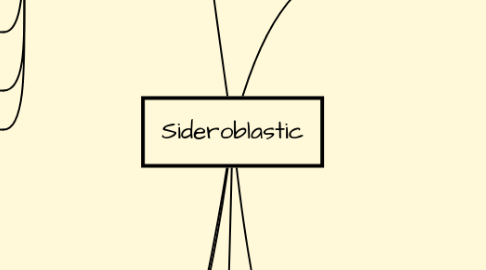
1. Etiology
1.1. Characterized by the presence of ringed sideroblasts within the bone marrow
1.1.1. erythroblasts that contain iron-laden mitochondria arranged in perinuclear collar
1.1.2. have increased levels of iron
1.1.3. blood contains hypochromic erythrocytes
1.2. Altered heme synthesis in erythroid cells in bone marrow
1.3. Heterogeneous group of disorders characterized by anemia of varying severity
1.3.1. caused by defect in mitochondrial heme synthesis
2. Findings
2.1. hemochromatosis (iron overload)
2.1.1. Respiratory manifestation
2.1.2. cardiovascular manifestation
2.2. Hemoglobin levels 4-10g/dl
2.3. Mild-Moderate enlargement of the spleen, liver
2.3.1. functions remains normal to slightly impaired
2.4. Abnormal skin pigmentation
2.5. Hemosiderrosis of cardiac tissue
2.5.1. hearty rhythm disturbances
2.5.2. congestive heart failure
2.6. growth and developmental impairment in infants and young children
3. Immunitiy
3.1. Acquired SA
3.1.1. Breakdown in bodies immune response
3.1.2. Improperly heme synthesis
3.1.3. toxin removal will treat
4. Types
4.1. Acquired SA
4.1.1. Leading know cause Myelodysplastic syndrome (MDS)
4.1.1.1. Disorders of hematopoietic stem cells
4.1.1.1.1. three stem cell lines demonstrating dysplastic characteristics
4.1.1.2. Morphologic and chromosomal characteristics that predict different clinical course
4.1.2. Primary disorder with no known cause
4.1.3. associated with other myeloproliferative or myleplastice disorders
4.2. Reversible SA
4.2.1. Secondary to various conditions
4.2.1.1. Alcohholism
4.2.1.2. Drug reactions
4.2.1.3. copper deficiency
4.2.1.3.1. Interfering with conversion of ferric iron to ferrous iron
4.2.1.4. hypothermia
4.2.2. Associated with alchoholism
4.2.2.1. results from nutritional deficiencies of folate
4.2.2.2. impairs heme synthesis by reducing activity of specific enzymes
4.2.2.3. Biosynthetic pathway and direct effects of alcohol
4.3. Hereditary SA
4.3.1. Rare, recessive x-linked
4.3.2. Exclusively in males
4.3.3. Missense mutations in the erythroid specific ALAS-E gene
4.3.3.1. ALAS first and rate-limiting enzyme
4.3.3.2. In heme biosynthesis pathway
4.3.3.3. Mutation lead to reduced synthesis of protoporphyrin IX
4.3.3.4. Characteristic accumulation of iron in erythrocyte
4.3.4. Affecting females
4.3.4.1. Mitochondrial mutations
4.3.4.2. Deficiencies of ferrochelatase
4.3.5. Genetic/ chromosomal
4.3.6. enzyme dysfunctions
5. Diagnostic test
5.1. Can be mistaken for deficiency for stem cells
5.2. Bone marrow examination
5.2.1. marrow is packed with
5.2.1.1. erythrocyte stem cells
5.2.1.2. mononuclear phagocytes
5.2.2. marrow are loaded with iron
5.3. Presences of sideroblasts confirms
5.4. Platelet and leukocyte values are generally normal
5.4.1. May be reduced if splenomegaly is occurring
6. Treatments
6.1. Supportive treatment
6.1.1. Transfusion
6.1.1.1. those who do not respond to Pyridoxine
6.1.1.2. Relieve symptoms
6.1.1.3. Permits growth and development
6.1.2. Removal of agent
6.1.2.1. PO Pyridoxine 100mg/day
6.1.2.1.1. Acquired SA
6.1.2.1.2. Alcohol abuse
6.2. Directed toward treatment/identification of causative agent
6.2.1. Hereditary SA
6.2.1.1. PO Pyridoxine 50-200mg/day
6.2.1.1.1. effective in 1\3 cases
6.3. Optimal response
6.3.1. Reticulocytosis
6.3.2. blood hemoglobin levels
6.3.3. low free erythrocyte protoporphyrin levels
6.3.3.1. Returning to normal within 1-2 months
6.4. Lifelong maintenance therapy at a lowered dosage is need
6.4.1. discontinuing therapy can cause relapse
6.4.2. those not responding to treatment
